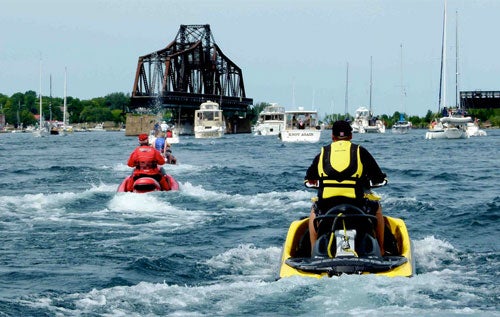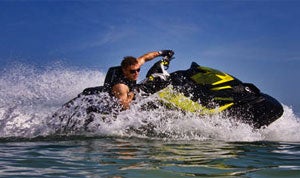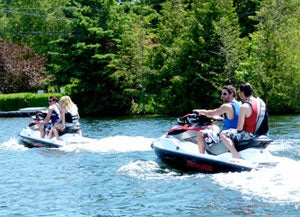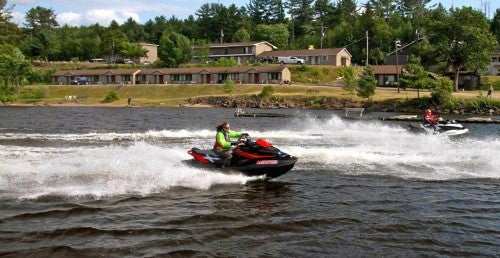Safe Boating Reminders For PWC Operators
Common-sense tips to keep you safe on the water
Boating and personal watercraft traffic will likely never be heavier than it is during the two-month period of July through August. Factor in the fact that a good number of those people on the water might be new to boating, and you’ve got potential for a lot of conflict.
Keep yourself – and your passengers – safe this summer by keeping in mind these three common-sense tips.
Learn the Basic Rules of the Road
Obviously a boating course is a great idea for any PWC operator, but if you’re looking for a refresher on any one topic, make it the rules of the road. Unlike roadways, waterways don’t have clearly defined lanes to control the flow of traffic. As a result, you’ll encounter other PWC and boats in a variety of situations. Knowing the basic rules will avoid collisions, help traffic to flow in an orderly manner, and keep everyone aboard safe.
 The summer months mean plenty of boaters on the water. Be careful out there.
The summer months mean plenty of boaters on the water. Be careful out there.Probably the most often used rules of the bunch? Remember to stay to the right when meeting another boat head on. It’s a life saver. Overtaking another PWC or boat from behind? Remember that you are the boat that has to give way. The boat being overtaken has every right to maintain their current course and heading. As the overtaking vessel, you need to move to one side or the other and safely pass.
It also goes without saying that boats not under power, like sailboats, canoes, kayaks, even standup paddleboarders, always have the right of way.
Look Before You Turn
 You may feel indestructible on your sporty PWC, but you’d be foolish to turn before looking over your shoulder.
You may feel indestructible on your sporty PWC, but you’d be foolish to turn before looking over your shoulder.If there’s one last piece of advice I emphasize to every new rider before turning them loose on the water, it’s to take a moment to look over your shoulder before you initiate a turn. All too often a PWC rider will get in that zone where they become oblivious to the traffic around them. Then, using a PWC’s incredible maneuverability, they’ll crank a turn, only to discover a boat is riding alongside, or attempting to overtake them from behind. The results are often tragic.
Always, always check for traffic in the direction you plan to turn. Only once you’ve verified the path is clear should you ever consider turning the handlebars.
Maintain a Safe Distance
 Keeping a safe distance between watercraft will help keep you safe on the water.
Keeping a safe distance between watercraft will help keep you safe on the water.PWC are personal watercraft, so it’s somewhat natural a pair of riders riding together will tend to run alongside each other, much like a pair of motorcycles cruise down the road. The problem is, too many things can go wrong and affect the path of either craft. Maybe it’s a wave, an oncoming boat, or a temporary distraction. Or maybe one craft just gets a little farther ahead of the other and then begins to turn (see above). Whatever the cause, the closer the proximity of each craft to the other, the greater chance serious injury and/or damage will occur.
I know a rental operator who demands riders stay at least 100 feet from each other at all times. I regularly see riders coming far closer, but keep in mind the idea behind that rule. The distance between your craft should be great enough that any conceivable situation can be avoided safely. Obviously, the less experienced the riders, the greater the distance should be.
Related Reading
PWC 101: Safety
PWC Riding and Turning Techniques
How To Tie Secure Knots for Your PWC
How To Make The Most Of A PWC Demo Ride
How To Find Good Service For Your PWC
Try PWC Touring [Video]
Get PersonalWatercraft.com in your Inbox!
Like PersonalWatercraft.com on Facebook
Comments
Most Popular

2025 Yamaha JetBlaster PRO 2-Up Review

Remembering the Sea-Doo XP

2024 Kawasaki Jet Ski STX 160X Review

Whatever Happened to the Wetbike?

2017 Kawasaki Jet Ski Ultra 310LX Review













 Your Privacy Choices
Your Privacy Choices